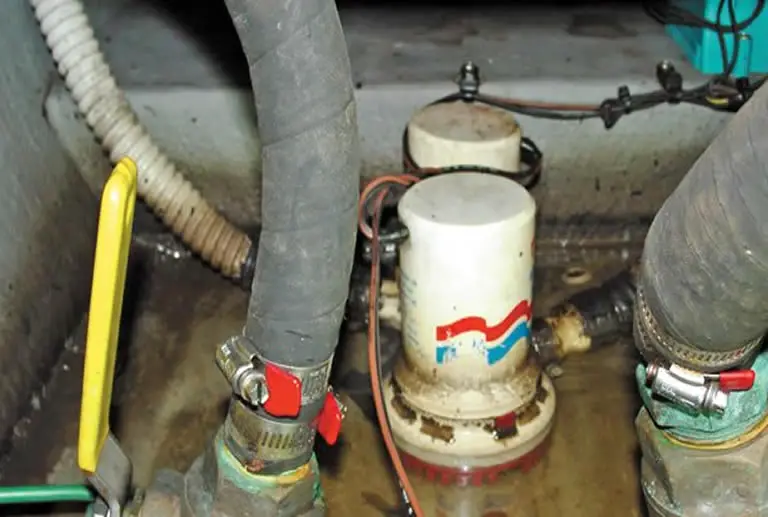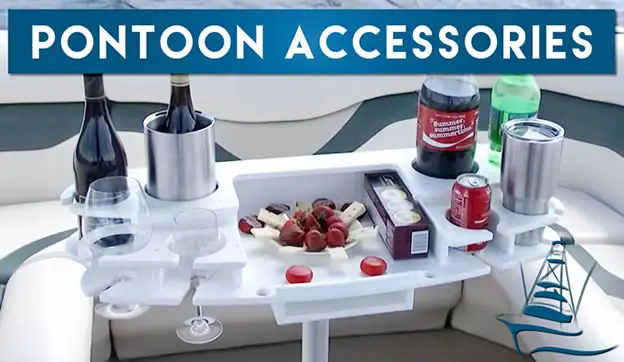All boats are subject to taking on a certain amount of water. Although smaller personal vessels, designed for individual use, must rely on other methods for removing water, larger vessels usually will have a bilge pump to help pump out the water.
But, because a pontoon boat is a uniquely designed recreational vessel that is usually used in calm waters many people wonder if a pontoon boat needs a bilge pump.
Contents
Pontoon boats don’t need bilge pumps
Although almost all large boats should be fitted with a bilge pump, pontoon boats are the exception. Modern pontoon boats are designed so they don’t need bilge pumps.
However, they are prone to taking on water in the pontoon tubes which can effect the performance and safety of the boat.
So, although pontoon boats do not accumulate bilge water in the hull, and thus don’t need a bilge pump, they do need bilge water to be occasionally removed from the pontoons.
Where is the bilge pump on a pontoon boat?
There is no bilge pump on a pontoon boat because a pontoon boat does not need one. Modern pontoon boats are designed so they do not accumulate water in the hull.
Their flat deck area is designed so that water washes off the boat and with an enclosed hull and enclosed engine pods there is no where for the water to get into the boat.
In areas where water could possibly get into the boat, such as the transom area just in front of the motor, there will be drainage holes that evacuate any water when the boat moves.
However, this does not mean that pontoon boats are immune to internal water build-up. They are.
However, the water will accumulate in a different place than it does with most other boats.
It is the pontoon tubes, which the hull sits on, that are at risk of water intake. Where most boats will have bilge water accumulate inside the hull, a pontoon boat will have water build-up inside the pontoon tubes.
Bilge water can get into the pontoon tubes though
It is important to occasionally check a pontoon boat’s pontoon tubes for water, as water in the pontoons will have a huge effect on the stability and the performance of the boat.
Most pontoons tubes are hollow and this mean they are prone to taking on water.
Water inside the pontoons can greatly decrease the performance of the boat but worse it can lead to a pontoon boat to nosedive and may even cause it to sink.
So, how does water get into the pontoons?
The pontoons on a pontoon boat are hollow tubes that are sometimes pressurized (for reasons we explain here) and sometimes are not. So a pontoon tube will be either completely empty or simply filled with pressurized air.
It is important these tubes remain either empty or only filled with air. When water gets into the tubes it makes the tubes heavier and thus affects the buoyancy of the pontoon boat and negatively affects how the boat works.
There should be nothing inside the pontoon tubes on your boat except air. So you need to check your pontoon tubes regularly to ensure bilge water has not got inside the tube.
How to remove bilge water from the pontoons
Obviously a bilge pump will not work to get water out of a pontoon tube so how do you remove it?
Most pontoon tubes are fitted with drain plugs. It is simply a matter of removing the plug so any accumulated bilge water can run out of the tube. This, of course, needs to be done when the pontoon boat is trailered out of the water or elevated above the water on a pontoon boat lift.
Some pontoon tubes are chambered to prevent a leak affecting the entire tube. If a leak occurs in the tube, the water that gets access to the inside of the pontoon is restricted from accessing to the entire tube and only gets into the one chamber that is affected by the leak.
If you have chambered pontoon tubes on your pontoon boat there may be drain plugs for each chamber. If there is not and you think there is water in the tube in a chambered area that you cannot access (due to poor boat performance or the tube sitting deeper in the water than it should be) you may need to contact the boat manufacturer or retailer for the steps needed to remove the bilge water from the tube.
The reason why you need a bilge pump on most boats
It is completely unnecessary to use a bilge pump on a pontoon boat but there are reasons for using one on other types of vessels. By looking at the reasons for using a bilge pump on other vessels you will clearly see why it is unnecessary to have one on a pontoon boat.
All boats take on water regardless of their size or usage. Even boats that have no bilge area are prone to taking on a certain amount of water. Small boats are not immune to this phenomenon either. Even a kayak will need to have water removed from its hull occasionally.
The water that accumulates inside a boat is called bilge water for reasons I will explain later.
Bilge pumps are necessary to remove bilge water that has accumulated in the boat. Without a bilge pump, bilge water would accumulate to levels that would make the water a major annoyance or it may even make the boat unsafe to use.
Bilge water can sink a boat if it is left to accumulate to dangerous levels. Even boats at the dock have sunk due to bilge water build-up.
Why pontoon boats don’t need bilge pumps
Pontoon boats, like any vessel, are prone to taking on a certain amount of water. However, modern pontoon boats are designed to not need a bilge pump.
Pontoons have closed engine pods and no lower decks. They also have drain holes in areas where water could access the inside of the boat. They therefore do not need bilge pumps. You do need to check the pontoon tubes for bilge water though as they are prone to taking on water.
Although a pontoon boat does not require a bilge pump because bilge water does not get into the boat, bilge water can get into the pontoon tubes. A pontoon tube filled with bilge water will negatively affect the boat’s performance and if left unattended will become a dangerous problem.
Although a pontoon boat does not need a bilge pump you may find that your boat could benefits from one or more of these 55 amazing pontoon boat accessories.
Why it’s called a bilge pump
As we have seen a bilge pump is a necessary piece of equipment for most boats. But where does it get its name from?
A bilge pump gets its name from the water it is designed to remove. A bilge pump is designed to remove water that builds-up in the bilge area of a boat. The bilge is the lowest inner part of a boat and is usually curved as it is designed to collect excess water that gets inside the vessel.
Not all boats have a bilge area, like a pontoon boat for example. However, the accumulated water inside the boat is still referred to as bilge water and the pump is still called a bilge pump for convenience.
Smaller vessels, like canoes and kayaks or skiffs for example, can use a small handheld bilge pump but for bigger vessels a mechanical bilge pump is needed as the bilge area is below deck and the water accumulation is greater.
Where bilge water comes from
Bilge water can from from multiple places. Even when there appears to be no obvious leaks in your boat you can still see a build-up of water inside the vessel over time. So where does all this water come from?
Water tends to get inside all boats, especially those with lower decks, and accumulates in the bilge area of the vessel. This water can come from leaks in the hull or lose fittings or from rainwater getting inside the boat. Other causes include, a weeping cooling system or a weeping freshwater water system and even condensation can add to the build-up of water.
Boaters can sometimes be perplexed about where the bilge water in their vessels is actually coming from especially when there seems to be no obvious cause after a thorough inspection of the boat. Unfortunately, bilge water is just something most boaters need to deal with if they want to enjoy boating on the water.
When you are on a large mass of water, and your vessel is surrounded by water, you have to expect some of it to get inside your boat and accumulate in the bilge. Of course, pontoon boats are the exception!
After seeing how bilge water gets into a boat, and why a bilge pump is needed to get rid of it in most boats, it should be apparent why the unique design of a pontoon boat means it doesn’t need a bilge pump.



